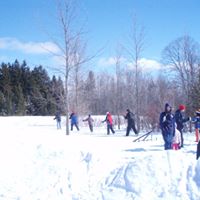 We call it “Our Winter Gift to the Community.” Snow and wind conditions permitting, the Crossroads at Big Creek Ski for Free program begins Thursday During the school vacation we will lend ski equipment and snowshoes Thursday through Sunday from 1:00-3:30 PM.
We call it “Our Winter Gift to the Community.” Snow and wind conditions permitting, the Crossroads at Big Creek Ski for Free program begins Thursday During the school vacation we will lend ski equipment and snowshoes Thursday through Sunday from 1:00-3:30 PM.
In January, whenever we have enough snow to groom the trails and wind chills are not excessive, our Ski for Free will be offered on Thursdays, Saturdays, and Sundays from 1:00-3:30.. Ski equipment and snowshoes in a wide range of sizes will be available from our Ski Distribution Center (a.k.a .the Maintenance Building), free of charge This program is staffed and sponsored by Friends of Crossroads and the Door County Silent Sports.
Ski trails at the Big Creek Preserve will be groomed whenever snow is adequate and where possible, the Multi-Use trails (hiking, biking, and snowshoeing) will be packed. Trails at The Cove and the Ida Bay preserves are open, but n
ot groomed nor are the parking areas plowed. Just as snowshoes and skis help humans traverse snow, special adaptations aid some animals. The best equipped “snow bunny” is the aptly name snowshoe hare. The hind feet of these winter-white hares are disproportionately large and each has four long toes which spread to a great width. The advantage of natural snowshoes is obvious to anyone who has seen the tracks. Hares can bound over the snow without sinking. Most predators just can’t make tracks fast enough.
When it comes to making tracks in the forest, ruffed grouse make quite an impression. Grouse are similar in size and shape to barnyard chickens, and like chickens, they spend a good deal of their time wandering around on the ground.
Each winter, grouse grow weird but effective little combs on the sides of their toes. These provide traction, actually double the surface area of the foot. Much like a snowshoe, the extended toes keep the birds from sinking in the snow.
Even whitetail deer are able to spread out their body weight as if they had snowshoes. The cloven hooves of deer are quite petite. But deer have small toes called dewclaws protruding from their lower legs. The small circular tracks made by dewclaws often show in snow, resembling prints made by a woman wearing high heels. In the snow, the dewclaws help support the weight of the animal by greatly increasing the surface area of each foot.
Yet, chest-deep snow can impede deer. Plowing through the snow with their bodies takes enormous energy. Thus, like cross-country skiers, these animals tend to create trails and to follow them whenever possible, a behavior called “trailing!” Deer often take advantage our nicely groomed ski trail trails. This is irritating, but not anywhere near as annoying as finding human tracks on Ski-Only Trails.
Trailing also is practiced by porcupines. Actually, porkies will avoid waddling through snow if they can. These prickly characters often stay in trees (where they feed on the inner bark) for days on end. When they run out of food or must find shelter from severe weather, stubby legged porcupines plow little trails from tree to tree or from tree to den. These deep troughs look like they’ve been swept with a whisk broom, for the porcupines drag their quill-covered tails through the snow. The porkie-paths often are well worn because they are used by all creatures great and small.
Otters don’t have natural snowshoes nor do they need to follow trails. They toboggan……on their bellies. These sleek mammals seem to make a game out of every facet of their lives and snow merely increases their recreational opportunities.

